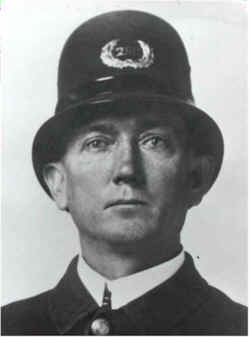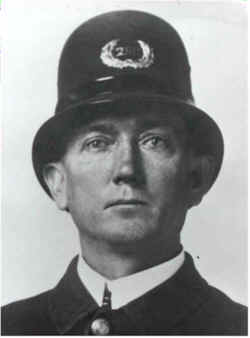f/o Fred Clark DeRossette
Officer John P. DeRossette, 33, a mounted policeman, was shot by one of two robbery suspects whom he attempted to arrest at Brightwood and Roosevelt Avenues, at 4:15 in the afternoon of January 24, 1917. The shot entered DeRossette's back and lodged in the abdomen. Officer DeRossette died of his injuries at City Hospital on January 30.
The shooting of Officer DeRossette was the climax of a search for two men who had robbed a number of groceries in previous days. DeRossette ran across the suspects as they were riding in the rear of a moving van and recognized them from descriptions that had been give to police by victims of the robberies. The shooting occurred in front of the Joseph Schaffer barber shop on Brightwood Avenue, near Roosevelt Avenue.
In at statement made at the scene before he was taken to City Hospital, Officer DeRossette said he called to the suspects, "What are you doing on that wagon?" He approached the suspects, and they jumped from the wagon. One of the suspects "drew his revolver before I had a chance to cover him, while I was searching the other man," DeRossette said, "and fired at me. I staggered back and leaned against a building and got my revolver out of my pocket. I started to fire, but the horses on the wagon became frightened by the shot and ran forward, shielding the (suspects). I fired five shots at them."
The suspects fled the scene, running toward the Big Four Railroad. Squads of police were detailed to aid in a search, and the facts of the shooting and description of the men were given to all the policemen in the city through the Gamewell system. Patrolman Henry C. Wilharm captured the suspects as they walked south on Highland Avenue. The prisoners identified themselves as Claude Taylor and Ernest Cooley. They were taken to City Hospital where DeRossette identified them as his assailants. After Officer DeRossette's death on January 30, Taylor was slated for murder and Cooley was charged with being an accessory to the murder.
Officer DeRossette was appointed to the Police Department in April 1910. He was placed on the police honor roll because of his fearless work performed during the flood of 1915. During most of his service, he was a mounted policeman, assigned to the Brightwood district.
Officer DeRossette was buried at Crown Hill Cemetery. The funeral procession was escorted by the mounted squad, the drill team, and the Police Band. Cola, the white horse which Officer DeRossette rode throughout his service as a mounted policeman, was led in the procession.
Officer DeRossette was survived by his wife.
Source: Indianapolis Star, January 25 and 31, 1917
Johnnie and three of his brothers, Kellar, Jessie, and Joseph, all served as officers in the Indianapolis Police Department.
f/o Fred Clark DeRossette
Officer John P. DeRossette, 33, a mounted policeman, was shot by one of two robbery suspects whom he attempted to arrest at Brightwood and Roosevelt Avenues, at 4:15 in the afternoon of January 24, 1917. The shot entered DeRossette's back and lodged in the abdomen. Officer DeRossette died of his injuries at City Hospital on January 30.
The shooting of Officer DeRossette was the climax of a search for two men who had robbed a number of groceries in previous days. DeRossette ran across the suspects as they were riding in the rear of a moving van and recognized them from descriptions that had been give to police by victims of the robberies. The shooting occurred in front of the Joseph Schaffer barber shop on Brightwood Avenue, near Roosevelt Avenue.
In at statement made at the scene before he was taken to City Hospital, Officer DeRossette said he called to the suspects, "What are you doing on that wagon?" He approached the suspects, and they jumped from the wagon. One of the suspects "drew his revolver before I had a chance to cover him, while I was searching the other man," DeRossette said, "and fired at me. I staggered back and leaned against a building and got my revolver out of my pocket. I started to fire, but the horses on the wagon became frightened by the shot and ran forward, shielding the (suspects). I fired five shots at them."
The suspects fled the scene, running toward the Big Four Railroad. Squads of police were detailed to aid in a search, and the facts of the shooting and description of the men were given to all the policemen in the city through the Gamewell system. Patrolman Henry C. Wilharm captured the suspects as they walked south on Highland Avenue. The prisoners identified themselves as Claude Taylor and Ernest Cooley. They were taken to City Hospital where DeRossette identified them as his assailants. After Officer DeRossette's death on January 30, Taylor was slated for murder and Cooley was charged with being an accessory to the murder.
Officer DeRossette was appointed to the Police Department in April 1910. He was placed on the police honor roll because of his fearless work performed during the flood of 1915. During most of his service, he was a mounted policeman, assigned to the Brightwood district.
Officer DeRossette was buried at Crown Hill Cemetery. The funeral procession was escorted by the mounted squad, the drill team, and the Police Band. Cola, the white horse which Officer DeRossette rode throughout his service as a mounted policeman, was led in the procession.
Officer DeRossette was survived by his wife.
Source: Indianapolis Star, January 25 and 31, 1917
Johnnie and three of his brothers, Kellar, Jessie, and Joseph, all served as officers in the Indianapolis Police Department.
Family Members
Sponsored by Ancestry
Advertisement
Explore more
Sponsored by Ancestry
Advertisement










